This page contains affiliate links. Please read our disclosure for more info.
The difference between people who travel carry-on only and those who don’t is not necessarily what they pack but how they pack.
Below I share my tips on how to use packing cubes to fit more in your luggage and the best packing cubes and compression bags for travel.
During our 13 years of travelling with just carry-on luggage, we’ve learnt that how you pack is hugely important.
Most travellers agree that the best way to stay organised and save space is to use packing organisers.
They could be simple zip-lock bags or more durable (and environmentally-friendly) travel packing cubes or compression bags.
By using organisers, you can compartmentalise your travel gear with each bag or cube containing a different category of item.
Contents
- Why Use Packing Cubes and Organisers?
- Compression Bags for Travel
- How Do Packing Cubes Work
- The Best Packing Cubes
- Packing Cubes vs Compression Bags
- More Packing Posts
Why Use Packing Cubes and Organisers?
Using travel packing organisers has many advantages:
- Pack more efficiently – It’s easy to pack when you know what goes in each cube and how each cube fits in your luggage. It’s like a game of Tetris—rearrange the cubes and other items until they fit perfectly into your bag, and then stick with your system. You’ll feel less stressed when packing, as you know everything will fit.
- Find things easily – Your cubes work like drawers at home. You know what’s in them, so you can take out the relevant cube rather than rummaging around at the bottom of your suitcase.
- Save space – You can squeeze a surprising amount of clothes into a cube, so you can pack more. Compression bags are even better as they remove excess air.
- Keep clothes clean and dry – Some organisers are water resistant and all offer protection from dirt. They can also be used to protect clothes in dusty hotel drawers.
- Prevent overpacking – Limit what you pack by choosing an organiser for each category.
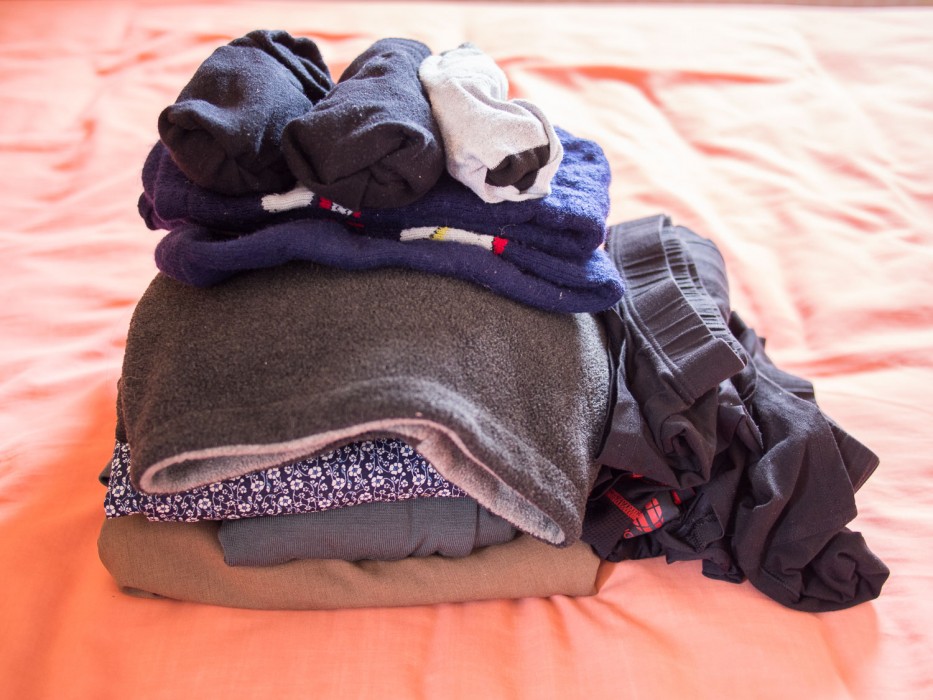
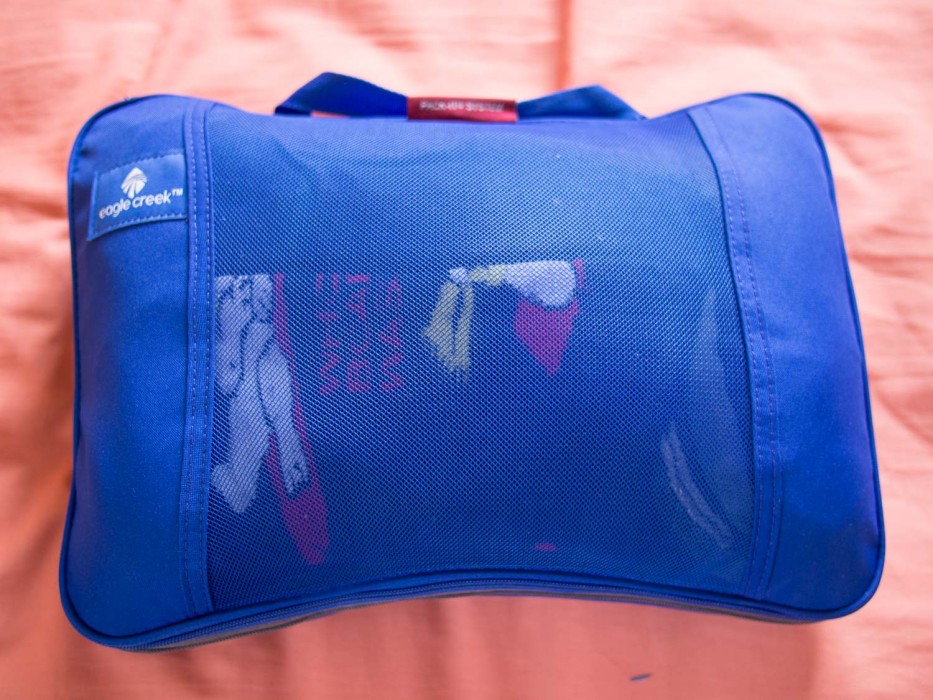
Creating your own packing system will make travel much easier whether you travel with a backpack or a suitcase—I highly recommend trying it.
There are a number of options:
Compression Bags for Travel
If you are struggling to fit everything into your luggage, consider travel compression bags for packing clothes.
These are sealable plastic bags with one-way pressure valves that let air out but not in. By removing excess air, your clothes are compressed, and you save space.
Compression packing bags work particularly well for bulkier items like fleeces and sweaters, so they are useful when packing for cold weather.
As the bags are airtight, they keep your clothes clean and dry—good to know if you get caught in a heavy rain shower or on a small boat with sea spray.
How to Use Travel Compression Bags
Compression bags are simple to use. You fold your clothes and lay them flat inside the bag, seal the zip-lock top, then roll the bag, squeezing out all the air.
It helps to do this on the floor and perhaps kneel on it to use your body weight to squeeze out as much air as possible.
When choosing a compression bag, make sure it is suitable for travel—you should be able to remove the air by rolling it rather than with a vacuum cleaner.
Some luggage compression bags are flimsy and tear easily; it’s worth investing in a durable bag, as it’s difficult to find replacements abroad.
Compression packing bags come in a range of sizes. You can choose a large bag for all your clothes or smaller bags to separate items.
The downsides of compression bags are that your clothes get a little creased; you have to uncompress the bag to access items—not very convenient if you need something on a travel day—and they can tear, which is why it’s worth paying more for a sturdy bag.
It can take effort to roll the bag, especially if it’s full. I admit I got Simon to roll mine whenever possible, as he was better at removing the air than I was.
It’s also annoying if the seal isn’t very good and the air leaks out, expanding the bag and making it a struggle to fit in your luggage. We haven’t had this issue with good quality bags, though.
The Best Compression Bags for Travel
I’ve tried a range of clothes compression bags. My favourite are the robust Packmate travel roll storage bags, which come with a lifetime guarantee and free replacements of the slider that seals the bag. Unfortunately, they are only available in the UK.
The Eagle Creek Pack-it compression sac is also excellent—the plastic is nylon reinforced, and it is covered by Eagle Creek’s lifetime warranty.
It can be hard to find, though. The Cozy Essentials travel roll up bags are an alternative, although we haven’t tried them yet.
Don’t confuse plastic rollable compression bags with nylon compression sacks, like those used to store a sleeping bag. Some travellers use these, but you are better off with compression bags, which remove more air, or packing cubes, which keep your clothes more organised and accessible.
For five years we both travelled with a large compression bag for our clothes. They worked well, but we eventually tired of rolling the bags and switched to a new type of compression packing cube. I explain how do compression packing cubes work below.
We do still occasionally use roll up compression bags, especially if we are travelling to a cold destination with bulky clothes.
How Do Packing Cubes Work
What are Packing Cubes?
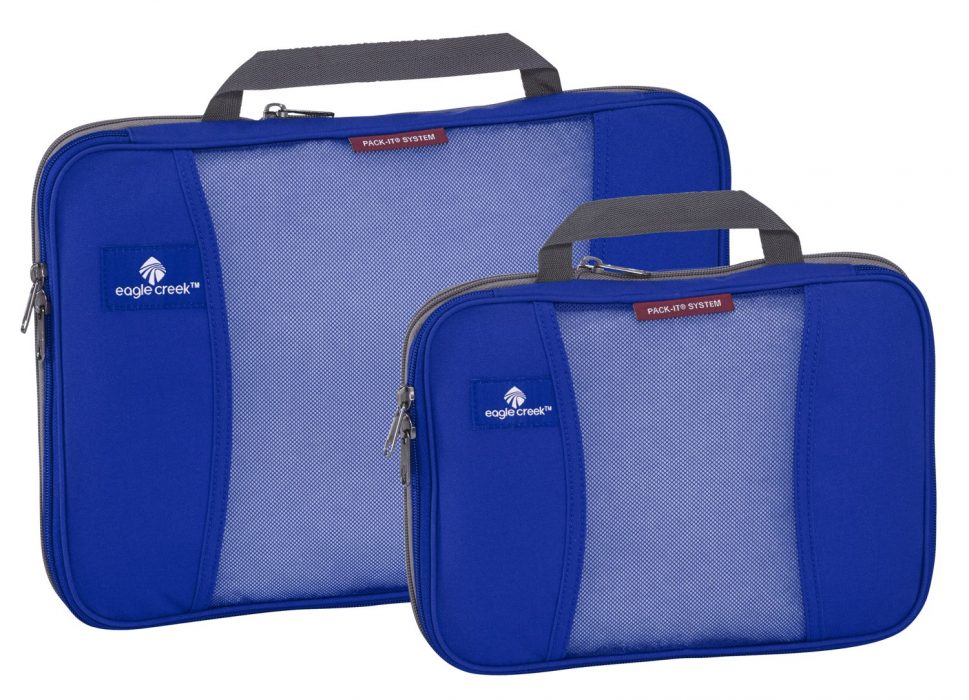
Packing cubes are zippered fabric containers, usually in a rectangular shape, for organising your items and making them easier to find in your luggage. They come in a range of sizes and are often sold as sets.
Unlike compression bags, you can use them to organise all kinds of gear, not just clothes.
For example, you could have one large cube for your clothes, a small cube for underwear, and another for your electronic accessories—chargers, cables, etc.
You know exactly where each item is kept, and when you need it, you just take out the appropriate cube.
Using packing cubes has some advantages over compression bags:
- It’s easier to access your clothes, as you don’t need to release the air
- They are more durable
- They stack neatly in your luggage
- Your clothes will be less creased
The downside is that, although they take up less room compared to packing your clothes loose, they don’t compress as much as a bag designed for that purpose.
Are packing cubes worth it? While they can seem pricey at first, we’ve found that good quality cubes last years and are worth it to save space and keep your luggage organised.
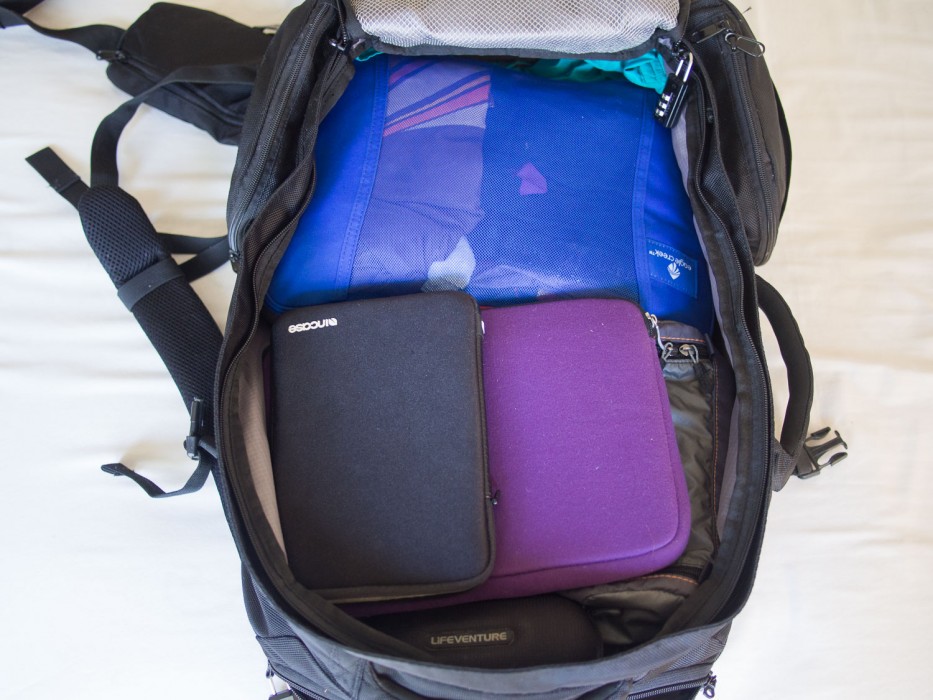
How to Use Packing Cubes
Packing cubes are easy to use—just roll or fold your clothes and place them inside the cube then zip it up.
I prefer to roll my clothes as it maximises space and makes it easier to access each item when they are in neat rows.
For bulkier items like jeans, I’ll fold them and place them in the bottom of the cube.
You can organise your cubes however you prefer such as by type of clothes or activity—use different colours to make them easy to identify.
I currently have a small cube for underwear and socks, another small one for workout gear, and two medium cubes for other clothes. As I’m travelling between variable climates, I use a different cube for summer clothes and winter clothes.
Some people choose to have a cube for tops and another for bottoms.
If you are travelling as a family, use a different colour for each person.
How to Use Compression Packing Cubes
Compression packing cubes work is much the same way as regular packing cubes.
The difference is that compression cubes have an additional zipper around the side of the cube. This allows you to squeeze the cube down even further.
Start with the side compression zips unzipped, pack your cube as above, and zip up the main section.
Then once your cube is full, zip up the side zip, and it will become even more compact.
If your cube is quite full (as mine usually are!), you might need to push down your clothes and do the zip up slowly to get it to close all the way around.
Yes, it’s a bit more work than a regular packing cube, but it does make the cube smaller and easier to pack.
How to Choose Packing Cubes
Popular packing cube brands include Eagle Creek, Peak Design, and REI.
When choosing packing cubes, durability is the most important attribute—you want a strong material with quality zips so that you can stuff as much in as possible without them breaking.
The size and other features come down to personal preference and how you want to organise your things.
Many cubes have a mesh top for breathability and so you can see inside—I don’t find this necessary as I know what’s in my cubes.
If you buy cubes in different sizes and colours, identification is easy. This is useful for families sharing a suitcase—each family member could have a different coloured cube.
The Best Packing Cubes
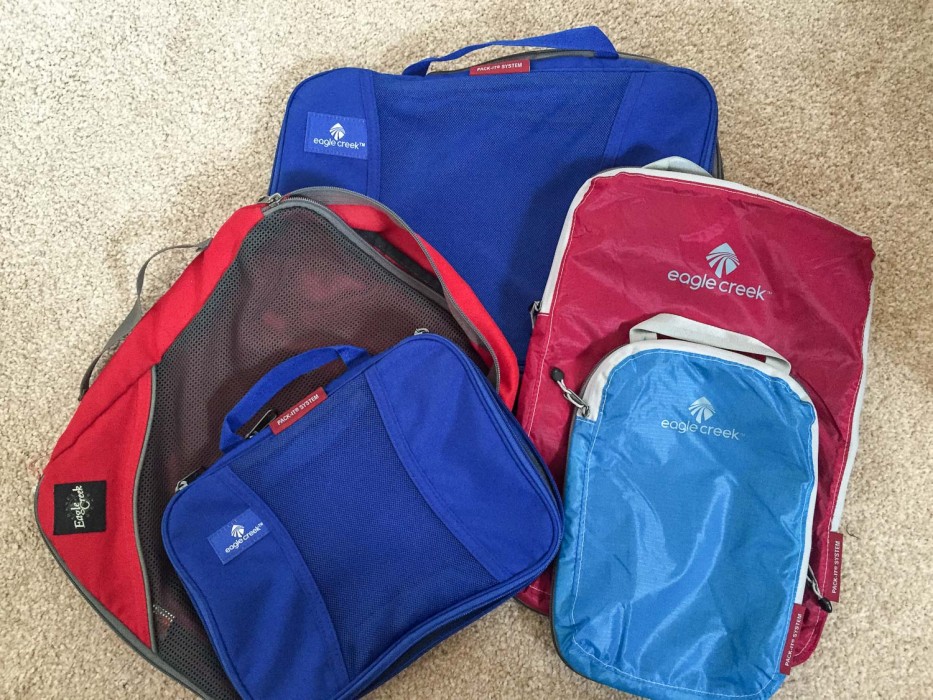
I’m a big fan of Eagle Creek packing cubes. The build quality is excellent, and they come with a lifetime warranty.
I have used one of the older style Eagle Creek Pack It cube with a mesh top for 13 years of constant travel, and it’s still going strong.
When we decided to switch from compression bags to packing cubes, we tried Eagle Creek compression cubes, which are like ordinary cubes but with a compression zipper around the side that squeezes them into a smaller size.
They turned out to be the perfect compromise. We could fit everything we needed into the cube, but it’s easier to use than a compression bag, with quick access and no need for rolling the bag.
There’s a whole Eagle Creek Pack It system including cubes, travel bags (for small items), and packing folders (to minimise wrinkles in shirts and trousers).
We travel with the cubes for our clothes and the Etools Organizer Pro (no longer available but this Bagsmart electronics organizer is similar) for our electronics cables and accessories.
Although I’ve been an Eagle Creek loyalist for years, Simon now travels with Peak Design packing cubes—see the full review below.
Eagle Creek Reveal Classic Packing Cubes
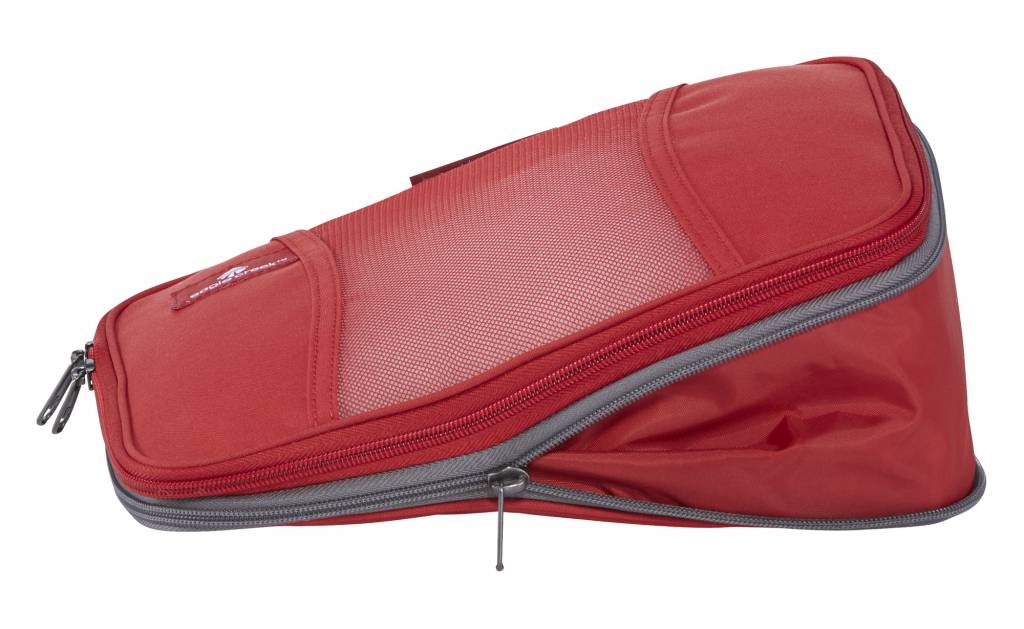
For years Simon travelled with the Eagle Creek Pack-It compression cube with a mesh top, and we still think it’s an excellent packing cube.
A newer version is the similar Eagle Creek Pack-It Reveal cubes, although this no longer has a compression zip.
The advantages of this classic Eagle Creek cube design is that it has more structure, it unzips on three sides for easy access, and the mesh top allows you to see inside. It’s also cheaper.
It’s heavier than the Specter or Isolate cubes (see below), but the fabric is more robust and long-lasting.
Eagle Creek Lightweight Compression Cubes
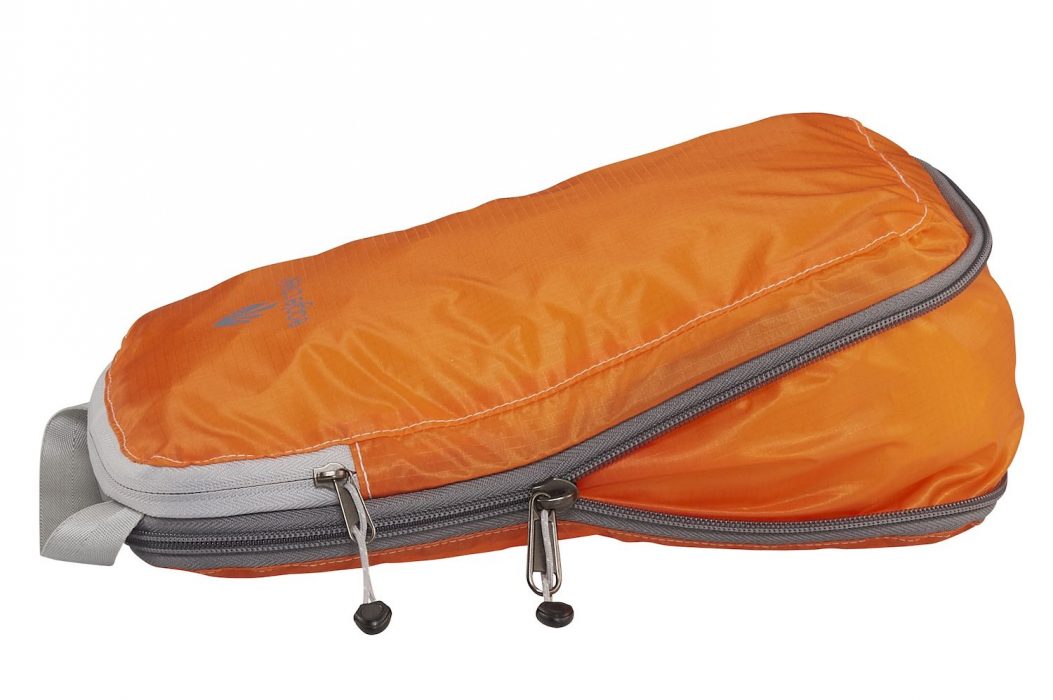
I use the Eagle Creek compression cubes—a mix of the older Spectre cubes and the newer Pack It Isolate cubes.
I have two medium cubes for my main clothes and a small cube for my workout clothes.
These ultralight packing cubes are the lightest on the market, made from translucent silnylon ripstop.
Specter and Isolate cubes are more expensive than the mesh cubes, but they are water and stain resistant and are amazingly light.
Eagle Creek Specter Cubes
A medium Specter compression cube weighs 57 g/2 oz, which is much lighter than the mesh compression cube (134 g/4.7 oz).
The biggest downside of the Specter cubes is that they only unzip part the way around, not on three sides like most cubes.
This makes clothes slightly less accessible, but as I roll my clothes, I can easily reach in and grab what I need.
As the fabric is so much lighter, they are not as robust as the mesh cubes. After about four years of constant use, one of my Specter cubes tore along the seam. I do really pack it full and squeeze the zippers tight though.
The new Isolate cubes are more robust—see below.
You can sometimes get better deals on the Specter cubes, so I still think they are worth considering.
Click here for current prices and reviews of the ultralight Eagle Creek Specter compression cubes.
Eagle Creek Isolate Cubes
The newer Eagle Creek Isolate compression cubes are slightly heavier than the Specter cubes (a medium is 2.6 oz/ 73 g), but they have solved a couple of the issues.
The fabric and zips are more robust, and I haven’t had an issue after 18 months of travel with them.
They also open fully on three sides so it’s easier to access your clothes.
Overall I think Eagle Creek Isolate cubes are the best compression packing cubes. They are light, robust, and squeeze a surprising amount in.
Buy the Eagle Creek Isolate cubes here.
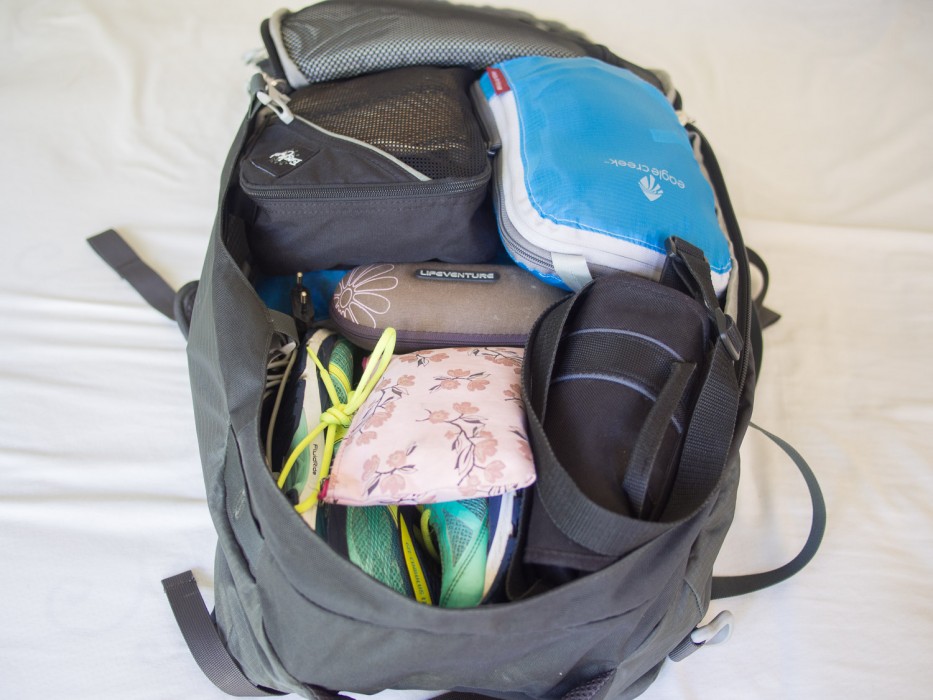
Peak Design Packing Cubes
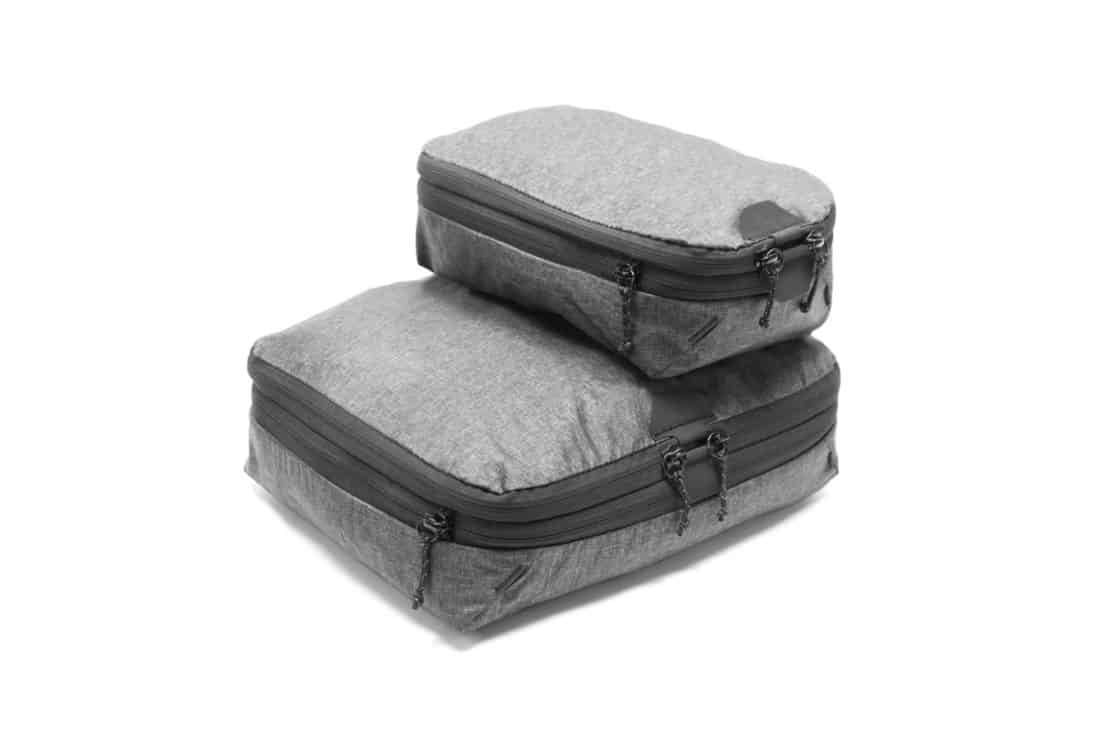
In recent years we’ve also been impressed by Peak Design Packing Cubes.
Simon has now switched to using these with a medium for his clothes and a small for underwear and socks.
They are the most stylish looking cubes we’ve tried and are made from a lightweight 70D nylon/poly blend in an attractive grey colour.
They are similar to the Eagle Creek Specter and Isolate cubes in that they have a floppier rather than structured form, but it’s easier to access your clothes as they open fully on three sides.
They even have a unique tear-away zipper that allows you to quickly access the contents.
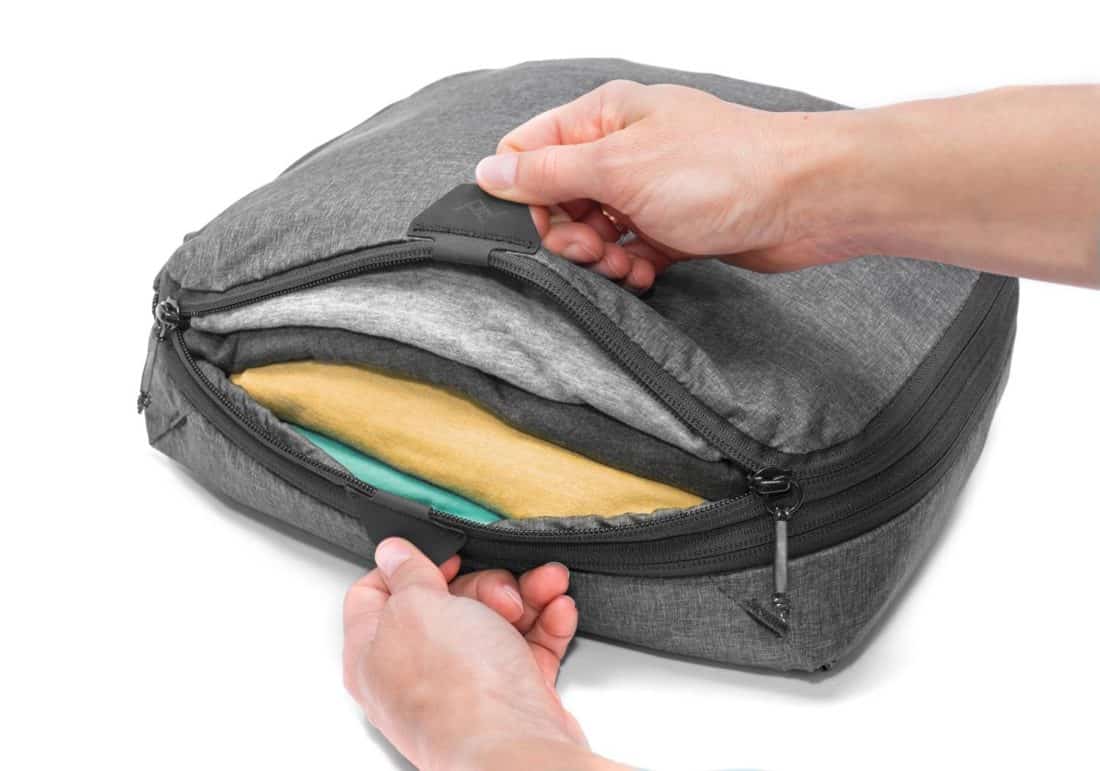
They also have a compression zipper around the side, but I find it doesn’t compress quite as much as the Eagle Creek compression cubes.
The medium Peak Design cube has a capacity of up to 18L, while a medium Eagle Creek Isolate cube is 14L, so the Peak Design medium does fit more in (a pro or con depending on how you like to arrange your stuff).
The Peak Design cubes are heavier than the Isolate at 144g (5.1oz) for the medium vs the Isolate’s 73g, but the extra features and space may be worth it.
You can certainly pack a lot in:
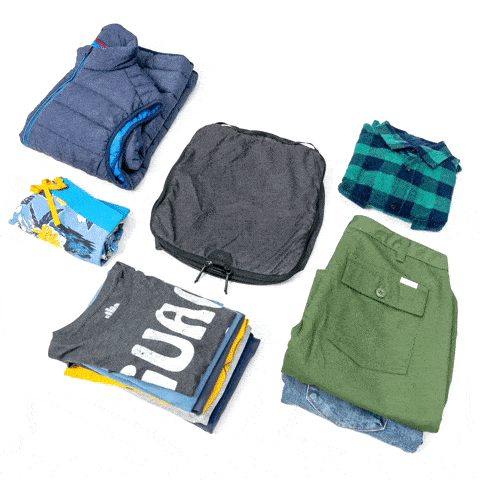
A really useful feature of the Peak Design cubes is the two separate compartments.
The top of the cube opens fully for you to store your clean clothes, and when they are dirty you can shove them in the bottom compartment (which opens along one side) to keep them separate.
Simon has been using his Peak Design cubes for four years and they look as good as new. They are well made with an abrasion and rip-resistant coating and are covered by the Peak Design lifetime warranty.
The Peak Design cubes are definitely a contender for the best packing cubes, especially if you want a more stylish design or a way to store dirty laundry.
Click here to buy the Peak Design packing cubes on the Peak Design website.
Or find Peak Design cubes on REI.
Packing Cubes vs Compression Bags
Should you use packing cubes or compression bags on your next trip?
Packing cubes are easier to use than compression bags, so I recommend starting with them.
If you are struggling to fit everything in or are travelling in cold weather or on a ski trip, try a compression bag instead.
A compression bag could also be used to bring home clothes purchased on your trip. Even if you use a compression bag for your clothes, packing cubes are useful for organising other items.
Compression packing cubes are the best compromise for us. I’ve been using my Eagle Creek compression cubes for full-time travel for eight years and they are perfect for me—even when I pick up extra clothes or travel in the winter, I can still fit everything in.
The Peak Design compression packing cubes are also well worth considering. Simon loves the stylish design, separate laundry compartment, and durable fabric.
Whichever luggage organiser you decide on, you won’t regret it. They create more space in your bag and make packing and finding items so much easier. They really are the secret to carry-on only travel.
More Packing Posts
- The Best Packable Daypacks for Travel
- The Ultimate Carry-On Packing List After 12 Years of Travel
- Iceland Packing List
- 50 Best Gifts for Travelers
- Airline Carry On Luggage Size and Weight Restrictions: A Detailed Guide
- Best Travel Pants for Women
- Allbirds Wool Runners: The Most Comfortable Travel Shoes
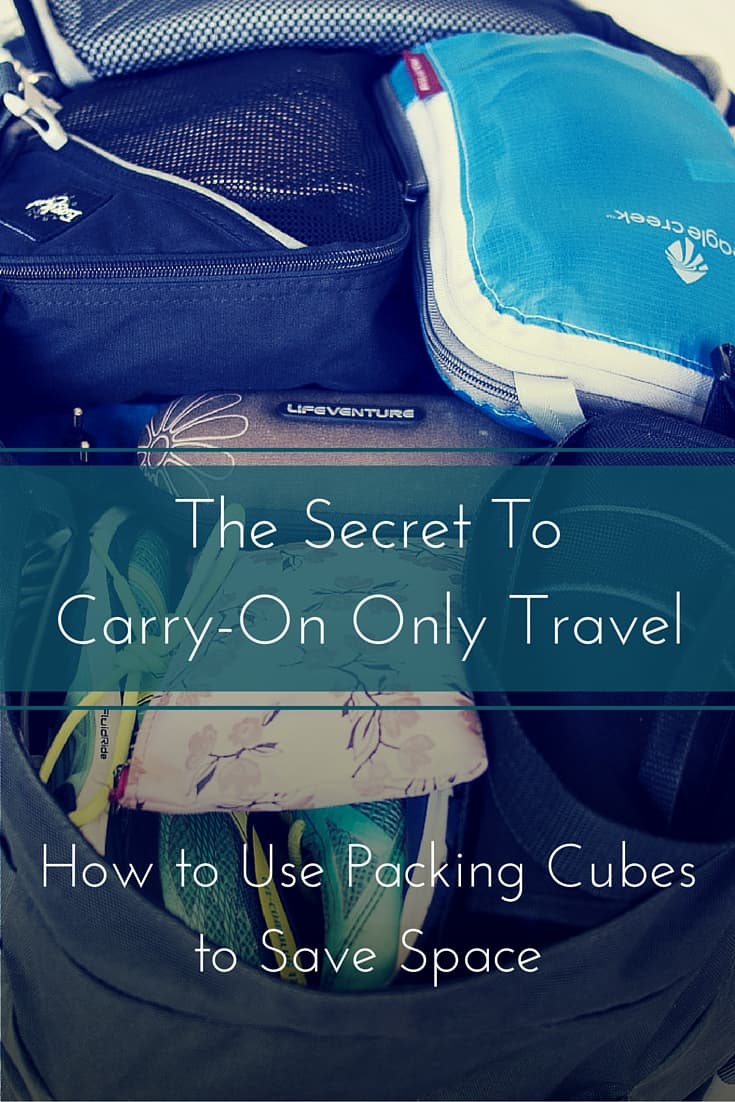

Thanks for the informative post, I’ll check out other aspects of your site :_
The title is ‘how to use packing cubes’. You don’t address the question posed.
What else would you like to know?
For the best compression bags, get the pac n stack bags. The set comes with a very small vacuum to remove air. Easy to put in your bag to use when you repack. Removes LOTS of air. I remove one of the 3 AAA batteries when traveling so the vacuum doesn’t turn on by accident. Can get on Amazon or through the pac n stack website.
Thanks for the tip!
Where did my comment go? I spent ten minutes writing one; what happened? It is NOT spam, malicious, or any other detrimental comment to your site, so what happened?
Sometimes genuine comments get caught up in the automatic spam filter but I have approved it now.
Nice article, but three things that I think are important were NOT mentioned:
1- SIZE of clothing should be taken into consideration; my husband is 6′ and I am 5’7″. he also has some weight added onto his frame. NO WAY are these going to fit his clothes–even if he doesn’t have weight. These are for the small-average sized people. His shoes are a size 12; again, no way will these all fit, which is why we’re stuck with paying for luggage on planes.
2- The tighter you roll, squeeze, compress, etc. the more weight it becomes in your luggage\carry on\backpack. That is a law of physics. If you vacuum out air, it will cause the bag to weigh more. Do it this “new” (but not really new) way, then take that packing apparatus and weigh IT, using a luggage scale (Samsonite has a great one at $10) and you’ll be surprised at how much weight these are AFTER you’ve packed them.
and lastly,
3- It is EXTREMELY important that you weigh your luggage\carry on\backpack, since all of them also weigh something over 3 lbs. Even if you were to use a backpack or carry on to avoid checking luggage, some airlines REQUIRE you to weigh them.
The secret is to buy lightweight carrying equipment BEFORE you pack anything.
Nice article, except, there is no way you’re saving space with packing cubes. Unless they are negative space sci-fi cubes, you are filling more space with the cubes than without them. It’s the organizing that may make you feel like you’re saving space.
Love these tips! I’m a huge fan of carry-on only travel as well, and have only recently stumbled across the packing cube phenomenon. They really are a game changer. I have a pair of the Eagle Creek Spector, but I thing I’m going to add the compression versions to my arsenal. Thanks for the direction. Very helpful post.
I’m glad you found the post useful. Packing cubes really are amazing!
Hi…my name is Yustika i am really interested in buying any packing cubes, as mentioned the packing cube is to help to compress , organize your item when travelling and also to keep more space in luggage.
may i know how much space we can keep if using packing cube inside the luggage?
thank you.
It really depends on what you are packing. I recommend buying some and doing a test pack. It will definitely save you space and keep your luggage more organised!
I’ve been using one of those mesh top Eagle Creek cubes since 1997! Seriously! It has been to 51 countries with me.
But, I love the look of those compression cubes. I’ve never heard of those before and would love to try them out!
J
Wow! And I thought mine were doing well! I love how well made the Eagle Creek cubes are. The compression cubes are great as you can squeeze even more in. I keep buying more clothes but somehow they still fit!
Just came across this, excellent advice…thanks! I have a question though, what’s the best way to deal with dirty clothes and keeping the system working throughout the trip? That’s where I struggle, especially if we are moving around every few days to a new hotel…pack/unpack, pack/unpack ?
We keep stuff that isn’t that dirty (like trousers and t-shirts that don’t smell) in our main cube and pack our used underwear/smelly tops separately – I use a zip lock bag and Simon uses one of the spare compartments of his bag. You could also buy a separate packing cube for dirty laundry (the Eagle Creek Specter cubes would be good as they are so light) or Eagle Creek makes a cube especially for this purpose – you use one side for clean and one for dirty: http://amzn.to/2tAE0CD
What kind of backpack is that? (The gray one. )
Osprey Farpoint 40. Our review is here: http://www.neverendingvoyage.com/best-carry-on-backpack-digital-nomads/
I don’t have a Kindle and would like to purchase a hard copy of your book. When will a hard copy/paperback be available?
We have actually just released it so it should be showing up as a paperback in the Amazon store:
you know it is not good idea, don’t need to carty all the staff, just Take necessary clothes and in your bag will be enough room, it is very simple
The clue is the compression bags but I don’t know I am not that type of girl I always want to pack alot of things
Be careful with compression bags/cubes, because you can pack more in the allowed space it is easy to go over weight!
We do often go overweight (mostly because we have a lot of electronics to work on the road), but we never have our bags weighed. We find that compressions bags help make your bag look smaller, so the airline doesn’t notice it.
If you have a backpack, most airlines won’t even bother to weigh it in my experience. If you have a regular carry on it can cause trouble, though.
I love the Eagle Creek compression cubes! On our last trip to the US, we bought two sets of them with our R.E.I. dividend – best idea ever :) Makes organizing clothes so much easier, and saves space to boot!
That are fantastic, aren’t they? Glad you found them useful!
I use compression bags and didn’t know that compression cubes existed. I will give the cubes a try for easier access to my things. Thanks! I always learn something new/interesting from your posts.
I think they are pretty new. I hope they work out for you!
What a great post. Loved the idea. This reminds me of our last trip to Singapore with our Daughter. At that she was 1.5 years old and she was hooked on a particular brand of milk (that we were sure that it won’t be available in Singapore). We ended up packing 27 quarter litter bottles for her. Customs officer at Changi was bit nervous and curious why so much milk.
Any way will definitely give compression bags a chance during my next trip
Wow, that’s a lot of milk :) I hope the compression bags work out for you!
Packing has always been a torture for me. This post gave really great advice to soother my burden, I’ll definitely check out your book as well! Thanks a lot!